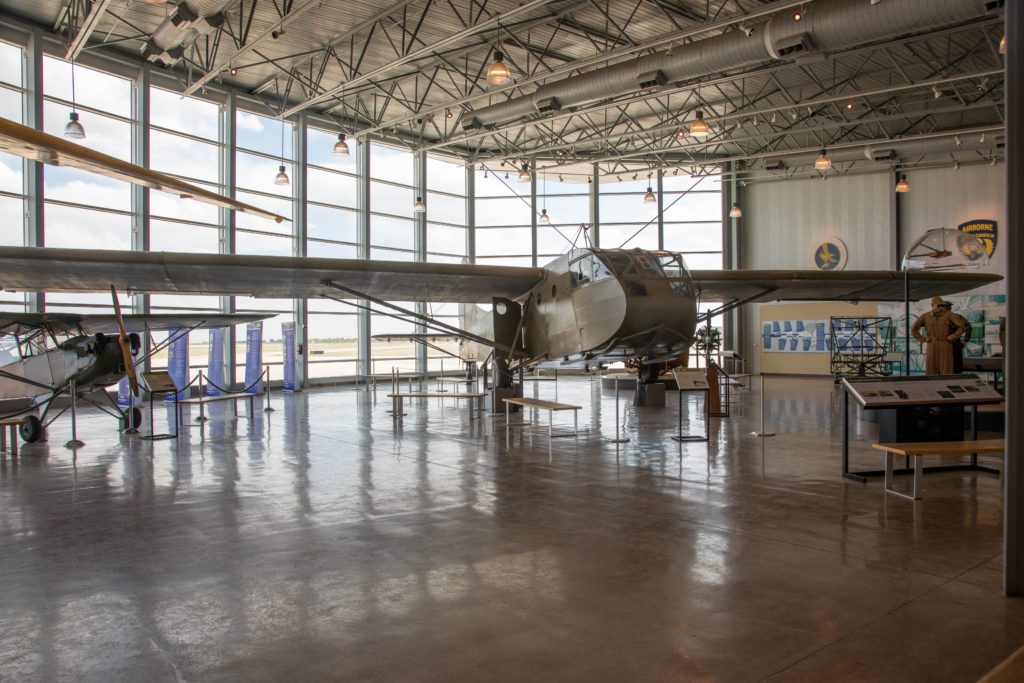 By Sean Robertson
By Sean Robertson
TTU MFA Arts Administration Candidate and LCAF Intern
What is a glider, how are the wings silent, and what makes the Silent Wings Museum different from any other museum? These were questions that I asked my children when we saw the sign on the highway which pointed in the direction of The Silent Wings Museum. This was a thrilling time as we were out on a family endeavor. My son loves planes, and this was an opportunity to share the history and story of the many brave people who earned their G-wings in the United States Army Air Force.
We began by entering the gift shop that contained souvenirs helping us to remember the visit. We were met by approachable and friendly staff. Sharon McCuller, the curator, shared, “The Silent Wings Museum is the one museum in the world dedicated solely to preserving the history of the American WWII Military Glider Program. The museum is home to one of the few accurately and completely restored CG-4A gliders left in the world. The National World War II Glider Pilots Association founded The Silent Wings Museum. Today it contains a growing collection of unique artifacts and archival material.” During WWII and 1942 through 1945 on the South Plains Army Airfield, over 80% of the United States Army Air Force-specific pilots were trained and called glider pilots. Currently located on that site stands Lubbock Preston Smith International Airport.
In 1971 Glider Pilots banded together to form the WWII Glider Pilots Association, Inc. They flew giant gliders the size of planes. These gliders carried significant military necessities, including Willys MB’s, much-needed supplies, and, most importantly, a few courageous soldiers to support the forces already on the ground. These gliders did not use engines, allowing them to silently fly beyond enemy lines undetected until often it was too late for enemies to stop the gliders. What made these pilots distinctive from the rest was that this was a one-way trip, and there was no turning around once the glider was lifted into the air by another plane. A typical military aircraft was armed with guns to help protect the pilot. With the glider, there was not any protection of that kind. They were made of light materials that bullets often pierced through on their descent.
One of my son’s favorite parts was finding the theatre that shows a 15-minute movie titled Silent Wings: The Story of the World War II Glider Program. Here he saw footage of the gliders flying and some of the fearless soldiers being qualified to receive their G-wings. My family moved through Combat Galleries and eventually came into a hanger that shows the museum’s crowning jewel, a fully restored WACO CGH-4A glider.
Exhibits focus on the training of the USAAF glider pilots, the airborne operations in which gliders were used, and the history of the Allied glider program. Exhibits frequently change to address specific aspects of this unique piece of World War II and aviation history. Starting in April of 2023, A Legacy Remembered will open, which “illustrates the perseverance and determination of the American Glider Pilot”. For eighty years, he acted in service to the country and then to make sure his story would live on.
Guided tours and research appointments can be scheduled. See the secret treasure displays of WWII gliders and remember those who gave us the freedoms we share today.
The museum is open Tuesday through Saturday, 10:00 am to 5:00 pm, Sunday from 1:00 to 5:00 pm, and closed on Mondays. There is an admission fee of $10.00 for adults and discounts for seniors, children, students, and the military. You can also visit the museum’s website for more information here.

